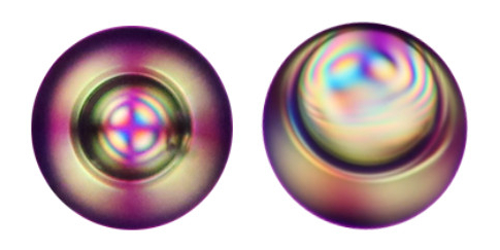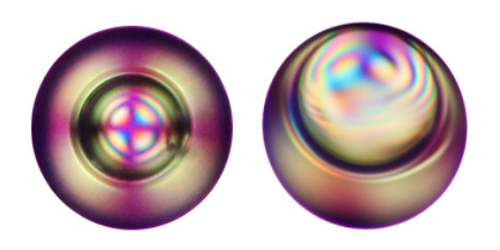Liquid Crystals Make Stronger Microcapsules
Self-propelling microcapsules that burst under specific conditions could be used as microsensors and drug-delivery vehicles. Scientists can make such capsules from two fluids by enclosing a drop of one fluid within a drop of another. But, these structures easily rupture if the inner drop is displaced from the center—which happens when the capsule moves. Now, Babak Vajdi Hokmabad at the Max Planck Institute for Dynamics and Self-Organization in Gottingen, Germany, and colleagues have developed a more robust fluid-based microcapsule, by incorporating a liquid crystal in the capsule’s outer layer. The structure—a so-called double emulsion a few tens of micrometers across—persists for more than half an hour, even when its propelled.
The team produced their microcapsules by merging the flows of two fluids: a water-based surfactant solution that formed the inner drop, and a nematogenic liquid-crystal oil that formed the outer drop. They found that the liquid crystal made the capsule’s outer layer stiffer than those made from isotropic oils. This stiffness stopped the inner droplet from breaching the external surface, keeping the capsule intact. However, above 34°C the oil loses its liquid-crystal structure, allowing the surfaces of the inner and outer drops to merge and the capsule to expel its contents. This temperature response could allow researchers to release the capsule’s contents on demand.
In addition to simplicity, double-emulsion microcapsules have another benefit: capsule self-propulsion. Immersing the microcapsules in a surfactant solution causes them to partly dissolve, losing small amounts of both oil and surfactant molecules. These leaked materials clump together in the solution to form oil-filled micelles that alter the surface tension between the solution and the capsules’ outer layer. The team found that an asymmetric accumulation of these micelles—which happens if the capsules are jolted, for example—creates a surface-tension gradient that propels the capsules along.
This research is published in Physical Review Letters.
–Marric Stephens
Marric Stephens is a freelance science writer based in Bristol, UK.





